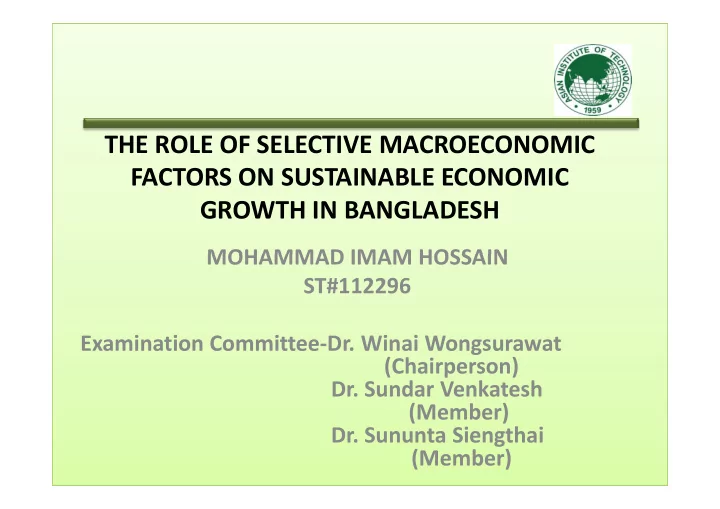

THE ROLE OF SELECTIVE MACROECONOMIC FACTORS ON SUSTAINABLE ECONOMIC GROWTH IN BANGLADESH MOHAMMAD IMAM HOSSAIN MOHAMMAD IMAM HOSSAIN ST#112296 Examination Committee-Dr. Winai Wongsurawat (Chairperson) Dr. Sundar Venkatesh (Member) Dr. Sununta Siengthai (Member)
Agenda of the Presentation • Rationale • Objectives • Literature Review • Literature Review • Growth scenario-Bangladesh • Results and Discussion • Conclusion and Recommendations
Rationale • To know the root cause of macro economy which influence the policy mix • Individual and organizational goals
Objectives • To investigate the relationship among the macroeconomic factors in Bangladesh. • To study the role of macroeconomic factors on GDP growth. GDP growth.
Methodology • Selection of Macroeconomic variables-GDP growth, inflation and budget deficits. • Literature review • Data from secondary sources- Bangladesh Bureau of Statistics (BBS), Bangladesh Bank(BB) etc from of Statistics (BBS), Bangladesh Bank(BB) etc from 1981-2010. • Basic growth regression model • Linear Regression analysis-IBM SPSS statistics, version 20. • Interpretation.
Project Framework Introduction Literature review Macroeconomic scenario of Bangladesh Macroeconomic scenario of Bangladesh Study of selective macroeconomic factors with regression Results and Discussion Conclusion and Recommendations
Literature Review • Stable macroeconomic framework • Economic ups and downs • Residuals effects for Bangladesh • Economic growth and development • Economic growth and development • Shocks or uncertainty to unsustainability • Explaining uncertainty-causal relationship between inflation and growth (De Gregorio, 1992; Fischer, 1993; Barro, 1995)
Literature Review(contd..) • Three distinct views about budget deficits- Keynesian, neoclassical and Ricardian approach • Empirical evidence-budget deficits (Fisher, 1993; Nelson and Singh, 1994; Ghura and 1993; Nelson and Singh, 1994; Ghura and Hadjimichael, 1996; Kneller et al., 2000; Adam and Bevan, 2005)
Literature Review(contd..) • Policy mix-an option • Coordinates -fiscal and monetary policies. • sustainable development -WCED, 1987. • “sustainomics” • “sustainomics” (Munasinghe, (Munasinghe, 1992 1992 and and Munasinghe, 2002) and “EDP” (Bartelmus 1994).
Economists Concern • World Bank economist Andrew Burns –Tight monetary policy to tame inflation (The Daily Star 2011, June 9) • Professor • Professor Wahiduddin Wahiduddin Mahmud-Creeping Mahmud-Creeping inflation creates difficulties (The Daily Star 2011, Oct. 7) • Dr. Mohammed Farashuddin-creeping inflation and energy crisis are the major concern (The Daily Star 2011, Oct. 7)
Growth Scenario-Bangladesh
Growth Scenario-Bangladesh
Existing Empirical Evidence… • Levine and Renelt (1992), Hossain and Cheng (2002) and Guerrero (2004) -inflation on economic growth. • Levine and Zervos (1992) -growth is positively associated with low inflation and larger budget surplus. with low inflation and larger budget surplus. • Easterly and Rebelow (1992) - consistent negative relationship between growth and budget deficits. • Mallik and Chowdhury (2001)-relationship between inflation and GDP growth.
Growth Regression Model • Basic regression model (Gujarati 2003) • impact of inflation and budget deficits on GDP growth in Bangladesh • Two independent and one dependent variable • Two independent and one dependent variable • Data-1981-2010 • Data points 28
Key Findings • Growth regression model - 39.5 percent of the variation in the GDP level • Inflation- inverse relationship • Budget deficit- positive relationship • Budget deficit- positive relationship • Zero inflation and budget deficits-GDP growth could be 4.6 percent
Conclusion • Prudent macroeconomic framework • Interactions among selected macroeconomic variables • Policy mix-Fiscal and Monetary policy • Policy mix-Fiscal and Monetary policy • Benefits of the project
Recommendations • Different countries and region • More macroeconomic indicators • Factors for development • Factors for development • Advanced econometrics model • Long and in-depth knowledge
Recommend
More recommend